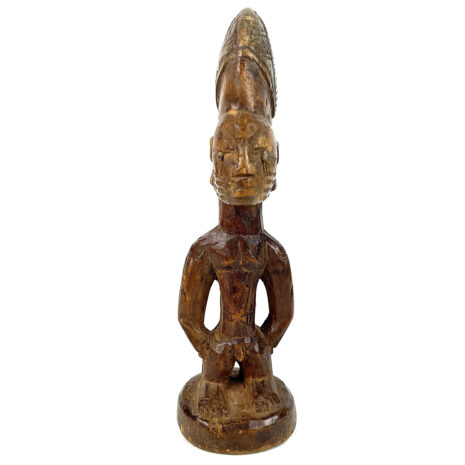Vintage Yoruba Ere Ibeji with High Hat, Nigeria #1963
Original price was: $465.00.$325.00Current price is: $325.00.
H: 7.125″ W: 2.125″ D: 2.25″ | Free Shipping IN CONTINENTAL U.S.!
This finely carved Ibeji has distinctive Yoruba features. The elongated head is narrow, has full lips, thick eyelids, incised lashes, flat prominent ears, a high stylized coiffure and scarifications. The strong stance with hands on hips, massive legs and arms are visible signs of fertility and power. The elongated head is where one’s spirit, intelligence and the seat of power lie. This vintage statue is finely carved with a smooth patina.
Description
Yoruba Ibeji carvings are idealized tribal art conforming to Yoruba cultural conventions and do not closely reflect human likenesses. Symmetrical and restrained with oversized, elongated heads where one’s spirit, intelligence and the seat of divine power lie, they have detailed linear coiffures that can be a third or more of the figure’s body size. Having one of the world’s highest rates of twin births but a high mortality rate, the Yoruba have developed a twin cult revering deceased twins as potent spirits, call them ere Ibeji and honor them with carved images to house their spirits and souls. They reflect 3 significant traditions: the importance of twins, and strong belief in the afterlife and their idealized form of beauty being an upright faultless example. They are an example of ideal Yoruba beauty which is in the prime of life, which is neither a child nor an old person. Each carving symbolizes moral virtue and inner goodness to be followed by all. Small for ease of handling and usually made of dense rubber tree wood with a fine grain and mystical power, when rubbed with oil the result is a fine patina. Mothers of the deceased commissioned carvers, often trained priests, to craft spiritual representations of the twin(s) to serve as resting places to contain their spirits. This finely carved Ibeji has distinctive Yoruba features. The elongated head is flat with full lips, thick eyelids, incised lashes, flat prominent ears and the nose and chin are centered with cheeks and eyes on opposite sides of a thin conical head. A stylized coiffure divides each side into sections with plaited linear designs and scarifications appear across his face The strong stance with hands on his hips is supported by massive legs low to the ground, his member is visible, the buttocks jut outward and both are signs of his fertility and power as are his thick rounded shoulders and arms. Sadly, in past decades demand for carved Ibejis has diminished, and since the 1970’s preferences have switched to purchasing imported dolls or photographs.
Additional information
| Weight | 2 lbs |
|---|---|
| Dimensions | 12 × 9 × 6 in |
| Place of Origin | Africa |
| Period | Vintage (1920-1980) |
| Date | 1940-1950 |
| Materials and Technique | Wood |
| Dimensions (inches) | Ht: 7.125” W: 2.125” D: 2.25” |
| Dimensions (metric) | Ht: 7.125” W: 2.125” D: 2.25” |
| Weight | 2.8oz |
| Condition | Very good, patina and wear consistent with age and use |
| Item Number | 1963BHA |
| Shipping Box Size |












